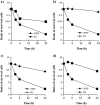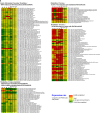Genetic and Transcriptomic Analyses of Ciprofloxacin-Tolerant Staphylococcus aureus Isolated by the Replica Plating Tolerance Isolation System (REPTIS)
- PMID: 30509938
- PMCID: PMC6355598
- DOI: 10.1128/AAC.02019-18
Genetic and Transcriptomic Analyses of Ciprofloxacin-Tolerant Staphylococcus aureus Isolated by the Replica Plating Tolerance Isolation System (REPTIS)
Abstract
We developed a simple, efficient, and cost-effective method, named the
Keywords: Staphylococcus aureus; ciprofloxacin tolerance; leuS; relA; tolerant mutant; transcriptome.
Copyright © 2019 American Society for Microbiology.
Figures







Similar articles
-
Assessing Antibiotic Tolerance of Staphylococcus aureus Derived Directly from Patients by the Replica Plating Tolerance Isolation System (REPTIS).Antimicrob Agents Chemother. 2022 Jan 18;66(1):e0096721. doi: 10.1128/AAC.00967-21. Epub 2021 Oct 25. Antimicrob Agents Chemother. 2022. PMID: 34694884 Free PMC article.
-
In Vitro Tolerance of Drug-Naive Staphylococcus aureus Strain FDA209P to Vancomycin.Antimicrob Agents Chemother. 2017 Jan 24;61(2):e01154-16. doi: 10.1128/AAC.01154-16. Print 2017 Feb. Antimicrob Agents Chemother. 2017. PMID: 27855063 Free PMC article.
-
RNA Sequencing Identifies a Common Physiology in Vancomycin- and Ciprofloxacin-Tolerant Staphylococcus aureus Induced by ileS Mutations.Antimicrob Agents Chemother. 2020 Sep 21;64(10):e00827-20. doi: 10.1128/AAC.00827-20. Print 2020 Sep 21. Antimicrob Agents Chemother. 2020. PMID: 32690649 Free PMC article.
-
[Susceptibility of Staphylococcus aureus isolated from blood to 11 antimicrobial agents and a review of the literature].Rev Esp Quimioter. 2002 Jun;15(2):158-68. Rev Esp Quimioter. 2002. PMID: 12582445 Review. Spanish.
-
Clinical relevance of mupirocin resistance in Staphylococcus aureus.J Hosp Infect. 2013 Dec;85(4):249-56. doi: 10.1016/j.jhin.2013.09.006. Epub 2013 Sep 21. J Hosp Infect. 2013. PMID: 24144552 Review.
Cited by
-
Transcriptomic profiling of ceftriaxone-tolerant phenotypes of Neisseria gonorrhoeae reveals downregulation of ribosomal genes - a pilot study.Microbiol Spectr. 2025 Aug 5;13(8):e0120725. doi: 10.1128/spectrum.01207-25. Epub 2025 Jul 7. Microbiol Spectr. 2025. PMID: 40622217 Free PMC article.
-
Evolution of Bacterial Tolerance Under Antibiotic Treatment and Its Implications on the Development of Resistance.Front Microbiol. 2021 Feb 26;12:617412. doi: 10.3389/fmicb.2021.617412. eCollection 2021. Front Microbiol. 2021. PMID: 33717007 Free PMC article. Review.
-
Antibiotic tolerance among clinical isolates: mechanisms, detection, prevalence, and significance.Clin Microbiol Rev. 2024 Dec 10;37(4):e0010624. doi: 10.1128/cmr.00106-24. Epub 2024 Oct 4. Clin Microbiol Rev. 2024. PMID: 39364999 Review.
-
A broadly applicable, stress-mediated bacterial death pathway regulated by the phosphotransferase system (PTS) and the cAMP-Crp cascade.Proc Natl Acad Sci U S A. 2022 Jun 7;119(23):e2118566119. doi: 10.1073/pnas.2118566119. Epub 2022 Jun 1. Proc Natl Acad Sci U S A. 2022. PMID: 35648826 Free PMC article.
-
Combating antimicrobial resistance: the silent war.Front Pharmacol. 2024 Feb 14;15:1347750. doi: 10.3389/fphar.2024.1347750. eCollection 2024. Front Pharmacol. 2024. PMID: 38420197 Free PMC article. Review.
References
-
- Sreedharan S, Peterson LR, Fisher LM. 1991. Ciprofloxacin resistance in coagulase-positive and -negative staphylococci: role of mutations at serine 84 in the DNA gyrase A protein of Staphylococcus aureus and Staphylococcus epidermidis. Antimicrob Agents Chemother 35:2151–2154. doi:10.1128/AAC.35.10.2151. - DOI - PMC - PubMed
Publication types
MeSH terms
Substances
LinkOut - more resources
Full Text Sources
Medical
Molecular Biology Databases

